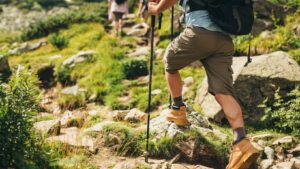When the warm weather beckons, the trails start calling. But what should you wear for a summer hike? It’s a question that often leaves outdoor enthusiasts scratching their heads. This article will guide you through the essentials of summer hiking attire, ensuring you’re well-prepared for your next adventure.
What To Wear When Hiking Summer
 Selecting the ideal materials, she’ll uncover, marks the first step to summer hiking outfit success. Materials like polyester and nylon, proven by Rivadavia et al. source to exhibit high wicking capability, remain the top recommendation. These fabrics pull moisture away from the skin, allowing for quick evaporation and maintaining a dry outlook.
Selecting the ideal materials, she’ll uncover, marks the first step to summer hiking outfit success. Materials like polyester and nylon, proven by Rivadavia et al. source to exhibit high wicking capability, remain the top recommendation. These fabrics pull moisture away from the skin, allowing for quick evaporation and maintaining a dry outlook.
Next, consider garment design. Long pants and sleeves, while sounding counterintuitive, offer optimal protection against the sun’s rays, insects, and vegetation, complementing the sunscreen detailed in section 2. Lightweight versions will not burden the gear and still provide the necessary shielding.
Lastly, it’s crucial to factor in specialty items. A hat with a wide brim, earmarked by Clark et al. source as an essential summer hiking accessory, shields the eyes and neck from sun exposure. The fit of the hiking boots, too, ensures comfortable traversing, preventing blisters or foot aches.
By adhering to these apparel guidelines, one can confidently tackle summer hikes, prepared for an array of trail conditions. Remember, the key lies in blending comfort with practicality for an effortlessly cool and protected summer hiking outfit.
Footwear Essentials for Summer Trails
 Stepping onto summer trails calls for attention to detail when it comes to footwear. The paramount choice is hiking boots, offering stability, protection, and traction. Hiking boots boast high-ankle support, notable when traversing uneven terrain. For lighter paths, hiking shoes, resembling running shoes but with sturdier soles, provide a great balance between weight and support, offering an ideal alternative.
Stepping onto summer trails calls for attention to detail when it comes to footwear. The paramount choice is hiking boots, offering stability, protection, and traction. Hiking boots boast high-ankle support, notable when traversing uneven terrain. For lighter paths, hiking shoes, resembling running shoes but with sturdier soles, provide a great balance between weight and support, offering an ideal alternative.
Socks matter as much as the shoes they’re in. Merino wool or synthetic socks aid moisture management, complementing the quick-drying nature of hiking boots. They add an extra layer of cushioning and, crucially, help prevent blistering – a common foe on extended hikes.
One must not underestimate the value of summer gaiters. Acting as an additional shield, gaiters protect from water, mud, and debris entering the boots or shoes. These mini leg-guardians enhance comfort on trails, making them an essential part of any summer hiking outfit.
Importance of Breathable Socks
 Maintaining feet comfort remains critical during summer hiking, and breathable socks play a significant role in that equation. These socks, often made of wicking materials like Merino wool or synthetics such as CoolMax and polyester, enable effective moisture management. Rapid evaporation of sweat and faster footwear drying times are the notable benefits. Breathable socks lessen the friction between the foot and the shoe, which, in turn, reduces the risk of blisters and hotspots.
Maintaining feet comfort remains critical during summer hiking, and breathable socks play a significant role in that equation. These socks, often made of wicking materials like Merino wool or synthetics such as CoolMax and polyester, enable effective moisture management. Rapid evaporation of sweat and faster footwear drying times are the notable benefits. Breathable socks lessen the friction between the foot and the shoe, which, in turn, reduces the risk of blisters and hotspots.
Even more importantly, these socks aid in temperature regulation for the foot. In summer’s hot conditions, keeping the foot cool is critical, and breathable socks facilitate that, improving overall comfort. Crucially, they help to prevent fungal infections, which can arise from extended periods of moist conditions. Opting for socks with these attributes enhances a hiker’s overall experience, reinforcing the importance of selecting appropriate socks for summer hikes.
Accessories to Enhance Your Hiking Experience
Extending on gear selection, accessorizing proves vital for a memorable hike. Sunglasses, for example, shield eyes from harsh sunlight and harmful UV rays. Go for ones rated with broad spectrum UV protection. Similarly, consider a hike-friendly wristwatch, aiding in navigation and monitoring health statistics. Water bottles aren’t just accessories, but essential survival tools. Opt for lightweight yet sturdy BPA-free versions. Using a hands-free hydration pack can also be advantageous.
Bug repellent bracelets, though often overlooked, protect from insect bites, and a lightweight, compact multipurpose tool might just become the hero in unforeseen situations. Lastly, trekking poles provide stability on uneven terrain.

